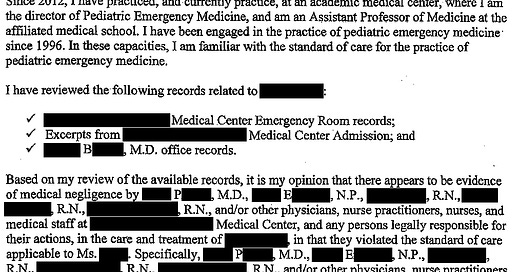A previously healthy 12-year-old girl presented to urgent care with coughing, shortness of breath, and a fever.
Her work of breathing was noted to be elevated.
Her temperature was 104.2F.
She was transferred by ambulance to the ED at a children’s hospital.
On arrival to the ED, she appeared to be doing somewhat better.
She was seen by a fellowship-trained and board-certified pediatric EM physician.
Her initial vitals:
Heart rate: 152bpm
Respiratory rate: 28/min
Temp: 102.9F
Oxygen saturation was in the mid-90s.
The court records thus far do not reveal what orders were placed.
However, the plaintiff’s attorney notes that the physician did not order an x-ray or prescribe Tamiflu.
She was observed in the ED for about 2 hours, and then discharged.
No repeat vitals were documented beyond those obtained at triage.
Join 8500+ doctors and attorneys on the email list.
Free and paid options available.
The next morning, the girl’s mother noticed that her breathing was worsening again.
Her temperature was 105.2F.
Her mother called the phone number for the ED and a nurse answered.
Allegedly, the ED nurse told her mother “not to bring her back to the hospital, but instead to make an appointment with her pediatrician”.
Her mother called the pediatrician, who scheduled her for a visit that afternoon.
However, the patient continued to worsen.
The child’s eyes “rolled back in her head”, at which point her mother called 911.
On arrival back to the same ED, she was noted to be in severe respiratory distress.
She was altered and not responding appropriately.
Her heart rate was 176bpm and respiratory rate was in the 80s (no saturation documented).
An initial attempt at intubation was unsuccessful, followed by a successful attempt.
In the ICU, she continued to be quite hypoxic.
It appears that she was put on VA-ECMO.
The patient ultimately survived, but suffered a stroke.
She was left with permanent right-side weakness, right-eye blindness, dysphagia, and unilateral vocal cord paralysis.
Her family hired an attorney and sued the hospital and PEM physician.
The expert witness opinion is shown below:
The PEM physician settled.
The case against the hospital is ongoing.
Join the email list to get updates as we approach the trial and more detailed updates are released!
MedMalReviewer Analysis:
Frankly there is too little clinical information here to develop a credible opinion about if this was negligent. The plaintiff’s attorney made the point several times that she was discharged in “just under 2 hours”, insinuating that her visit was too short. However, this seems to be an appropriate observation period and is well within normal practice.
In my opinion, if a child is sick enough to warrant a transfer from urgent care via ambulance, they should get discharge vitals after ED assessment and treatment. However, I showed this case to a few physicians, and many reported that their pediatric EDs do not always get repeat vitals if the child appears well (even if febrile and slightly tachycardic). What do you think?
It’s unclear if the child had a flu shot. While the flu shot is not 100% effective at preventing all influenza infections, it does provide significant protection against catastrophic complications like this.
Patients who call back to the ED after discharge present a challenge. The call is almost always answered by someone who did not see them. It’s difficult to provide good advice while knowing nothing about their original presentation and not being able to assess them. I don’t have any groundbreaking pearls here, just keep this situation in mind when answering these calls and be aware that “Go see your PCP” is not always the right answer.
Previous pediatric cases:









11 times out of 10, get that heart rate better. If the initial vials are normal (esp HR & RR), I don't always need d/c vials, but I've added the latest HR as a column in my epic track board to make sure I remember to make it normal before dc. Most kids will probably be fine, but most pediatricians know a story about a kid who was fine but persistently tachycardia who was actually in shock (or had myocarditis) and often suffered a bad outcome.